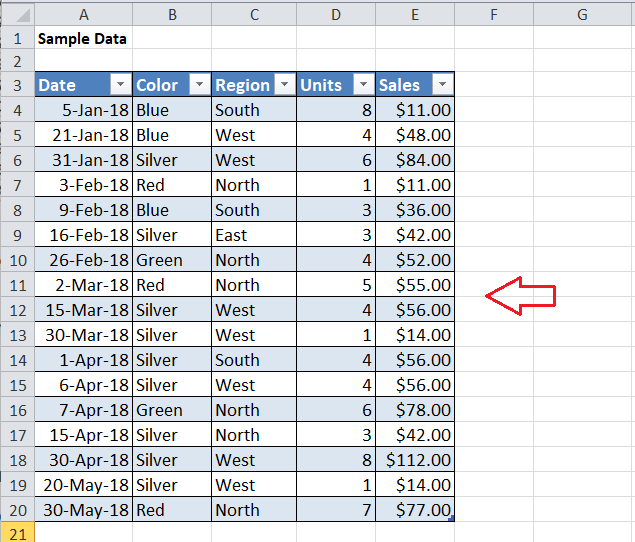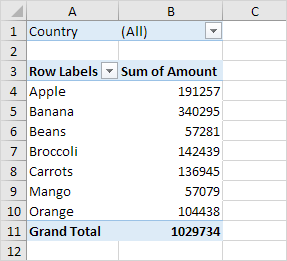

- #CREATING A PIVOT TABLE IN EXCEL 2016 HOW TO#
- #CREATING A PIVOT TABLE IN EXCEL 2016 UPDATE#
As a best practice, use parenthesis to make sure you don’t have to remember the order of precedence.
The order of precedence is followed in the formula that makes the calculated field. For example, if you want to know the forecasted sales where it is forecasted to grow by 10%, you can use the formula =Sales*1.1 (where 1.1 is constant). You can use a constant in the formula. However, you can use formulas that can work without references (such SUM, IF, COUNT, and so on.). That would rule out a lot of formulas such as VLOOKUP, INDEX, OFFSET, and so on. You CAN NOT use references or named ranges while creating a Pivot Table Calculated Field. However, you can also use some advanced formulas.īefore I show you an example of using an advanced formula to create a Pivot Table Calculate Field, here are some things you must know: In the above example, I have used a simple formula (=Profit/Sales) to insert a calculated field. Now you can use this calculated field as any other Pivot Table field (note that you can not use Pivot Table Calculated Field as a report filter or slicer).Īs I mentioned before, the benefit of using a Pivot Table Calculated Field is that you can change the structure of the Pivot Table and it will automatically adjust.įor example, if I drag and drop region in the rows area, you will get the result as shown below, where Profit Margin value is reported for retailers as well as the region. You can either manually enter the field names or double click on the field name listed in the Fields box.Īs soon as you add the Calculated Field, it will appear as one of the fields in PivotTable Fields list. In this case, the formula is ‘= Profit/ Sales’. In the Formula field, create the formula you want for the calculated field. Note that you can choose from the field names listed below it. Give it a name by entering it in the Name field. In the Insert Calculated Filed dialog box:. From the drop-down, select Calculated Field. Go to Pivot Table Tools –> Analyze –> Calculations –> Fields, Items, & Sets. Here are the steps to add a Pivot Table Calculated Field: Suppose you have a Pivot Table as shown below and you want to calculate the profit margin for each retailer: #CREATING A PIVOT TABLE IN EXCEL 2016 HOW TO#
Let’s see how to add a Pivot Table Calculated Field in an existing Pivot Table. For example, if the metrics change or you need to change the calculation, you can easily do that from the Pivot Table itself.Īdding a Calculated Field to the Pivot Table Once you add a Calculate Field, you can use it like any other field in your Pivot Table.
It’s scalable as it will automatically account for any new data that you may add to your Pivot Table. #CREATING A PIVOT TABLE IN EXCEL 2016 UPDATE#
It doesn’t require you to handle formulas or update source data.There are a lot of benefits of using a Pivot Table Calculated Field (as we will see in a minute):

Consider Calculated Field as a virtual column that you have added using the existing columns from the Pivot Table. This is the most efficient way to use existing Pivot Table data and calculate the desired metric. But when I changed it from customers to regions, the formula gave an error.

As shown below, I calculated the Profit Margin when there were retailers in the row. But if you change the Pivot table, the calculation may not update accordingly and might give you the wrong results or errors. This can be an option if your Pivot Table structure is unlikely to change. Add calculations outside the Pivot Table.This method also bloats your Pivot Table as you’re adding new data to it.Again you will have to add this column to your source data and then update the pivot table. For example, you may need to add another column to calculate the average sale per unit (Sales/Quantity). While this method is a possibility, you would need to manually go back to the data set and make the calculations.Once you do this, you need to update the source data of the Pivot Table to get this new column as a part of it. So you can insert a new column in the source data and calculate the profit margin in it. Go back to the original data set and add this new data point.Now, what if you also want to know what was the profit margin of these retailers (where the profit margin is ‘Profit’ divided by ‘Sales’). The above Pivot Table summarizes the sales and profit values for the retailers. Suppose you have a dataset of retailers and you create a Pivot Table as shown below:

Let’s start with a basic example of a Pivot Table.
How to Get a List of All the Calculated Field Formulas?ĭownload the dataset and follow along. How to Modify or Delete a Pivot Table Calculated Field?. An Issue With Pivot Table Calculated Fields. Adding a Calculated Field to the Pivot Table. What is a Pivot Table Calculated Field?.








 0 kommentar(er)
0 kommentar(er)
